VIP SERVICE
“You know about the sword, right?” Gonzalo, my Peruvian friend, was feeling confidential after the fifth beer at a watering hole in Lince, a noisy district near downtown Lima.
“Tell me.”
“The Captain’s sword. Brought with him from Spain. It’s said that it still hangs in a secret corner of the family house on Jirón de la Unión.”
The Captain was Jerónimo de Aliaga y Ramírez, conquistador and trusted right-hand man to Francisco Pizarro himself, the Extremaduran soldier who sacked Peru and founded the city of Lima in 1535. Aliaga was one of 168 Spaniards present in Cajamarca at the capture and garroting of the Inca Atahualpa, and for his efforts, then and during the subsequent campaign against Cuzco, he was rewarded with a prime piece of Lima real estate: a plot alongside the Governor’s Palace. It was there that he constructed the splendid mansion that remains in his family to this day.
“A mysterious blade,” I said. “More baroque rumors from colonial Lima.”
Gonzalo shrugged. The sword, he said, had accompanied Aliaga on his journeys. Or so the stories went. Its steel blade, forged some 500 years ago in the town of Solingen, had witnessed the melting-down of the gold paid to ransom Atahualpa, the siege of the Inca capital, the end of an empire.
“Supposedly you can take tours of the house,” Gonzalo said. “Personally, I’ve never seen it.” I smiled doubtfully. We ordered one more for the road.
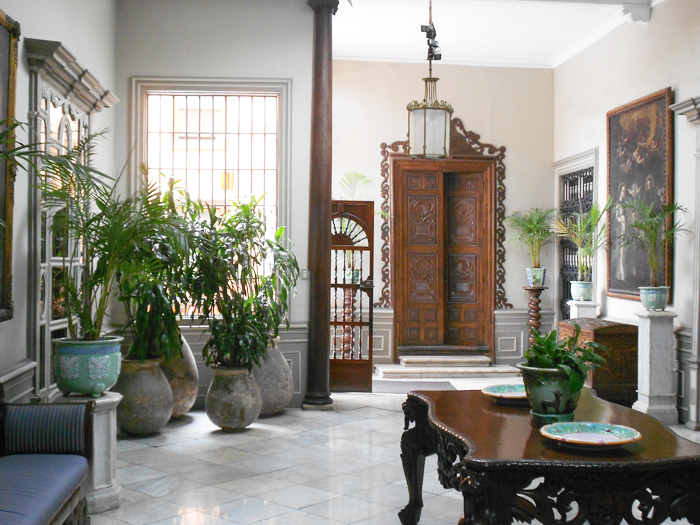
The next day, though, after sleeping off the beers, I woke up thinking of the sword. A family heirloom that was already an antique in Cervantes’s day. What were the chances? I decided to send an e-mail to the Casa Aliaga via their website, hoping to arrange a tour to see this keepsake.
The response was prompt. The Casa is the oldest private house in the Americas and has housed 18 generations of Aliagas, it said. It is not open to the public, but visits can be arranged through one of the guides approved by the family. Total cost: 140 soles (approximately $50).
Steep, the fee. No mention of a sword.
My skepticism increased. Still, I contacted one of the guides mentioned in the e-mail, Martha Tolmos León, who cheerfully agreed to meet me in downtown Lima at my convenience. The next day, at 11:00 a.m., we stood outside an inconspicuous dwelling in a bustling street next to the Palacio del Gobierno. There was no plaque, nothing to indicate that this edifice was anything unusual. Two tiendas selling ice cream and junk food took up the whole first floor.
Upon ringing the bell, we were greeted by the butler, who ushered us into a dark, echoing foyer with a monumental staircase. Only the city’s founders had the right to build steps that ascended straight ahead from the entryway, Martha told me. On the walls were paintings of the family’s coat of arms, with the motto Aliaga el caballero…en ambos mundos guerrero: “Aliaga the knight…warrior of two worlds.”
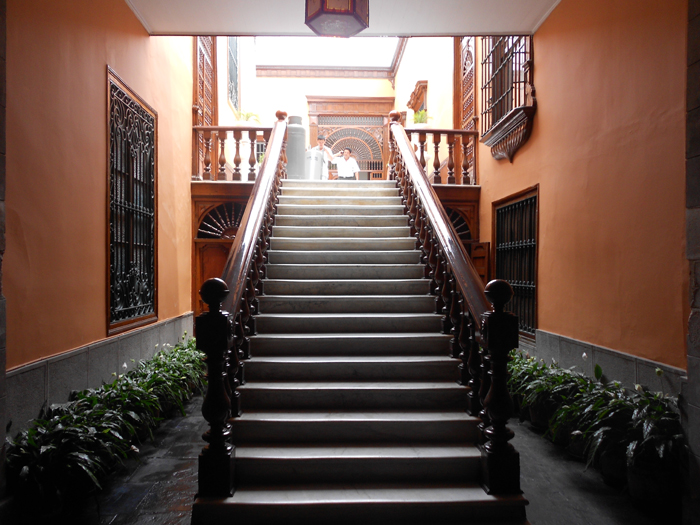
With the door shut behind us, we seemed to step back into the past. Above, on the mezzanine that leads to the main entry hall, stood a statue of Christopher Columbus, as though to signal our entrance into an older, vanished Lima. After marveling at the carved fanlight, we entered the house itself.
The vestibule, lit by a skylight, was graced by several colonial canvases from the School of Cuzco, among them an impressive St. Jerome. But it was the main salon, the Gold Room, that fully revealed the opulence of this ancestral home. Here gilded mirrors, Japanese vases, parquet flooring, and Louis XVI furniture all reflected the rococo tastes of the late-colonial era. Much of the original structure, Martha told me, had been destroyed by the earthquake of 1746. Subsequently, the family had rebuilt the house in accordance with the architectural styles of the day.
Charming, but no sign yet of any sword.
Martha next guided us to the central atrium, the most beautiful spot in the house. Here a covered gallery overlooked a sunken patio graced with a cast-iron fountain and a towering ficus tree. The walls, ornamented with Sevillian tiles and more paintings from the School of Cuzco, created a lovely interplay of light and shade as we stood listening to the purling of the water below. Behind us, a door opened onto the solemnity of the family’s private neo-Gothic chapel.
My doubts regarding the legendary armament were undispelled, but the aesthetic glories of the house were such that it had almost ceased to matter. Martha took me through the stately dining room, presided over by a contemporary portrait of the Captain, and the long main corridor, off of which lay a bedroom once used by Santa Rosa de Lima, a wealthy Lima matron and friend of the family. As we came to the final stop, she announced we were in the oldest part of the house.
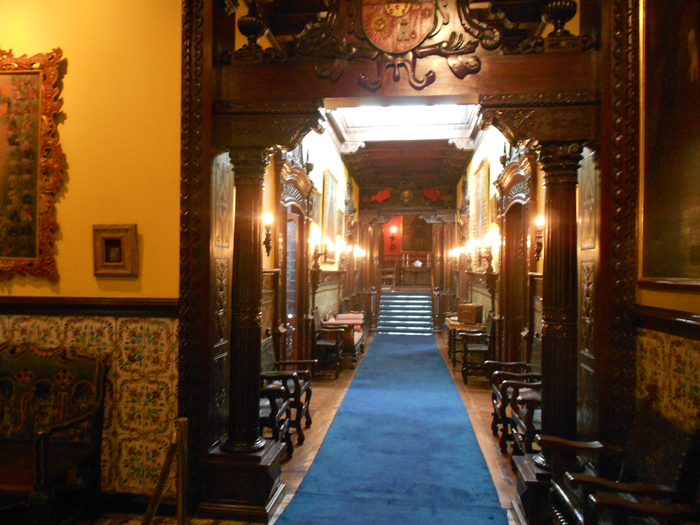
The Tile Room, it was called. It was truly spectacular, with hundreds of Sevillian azuletas inlaid into the walls and floor and a gorgeous carved wooden ceiling. All of it from the 17th century, miraculously preserved.
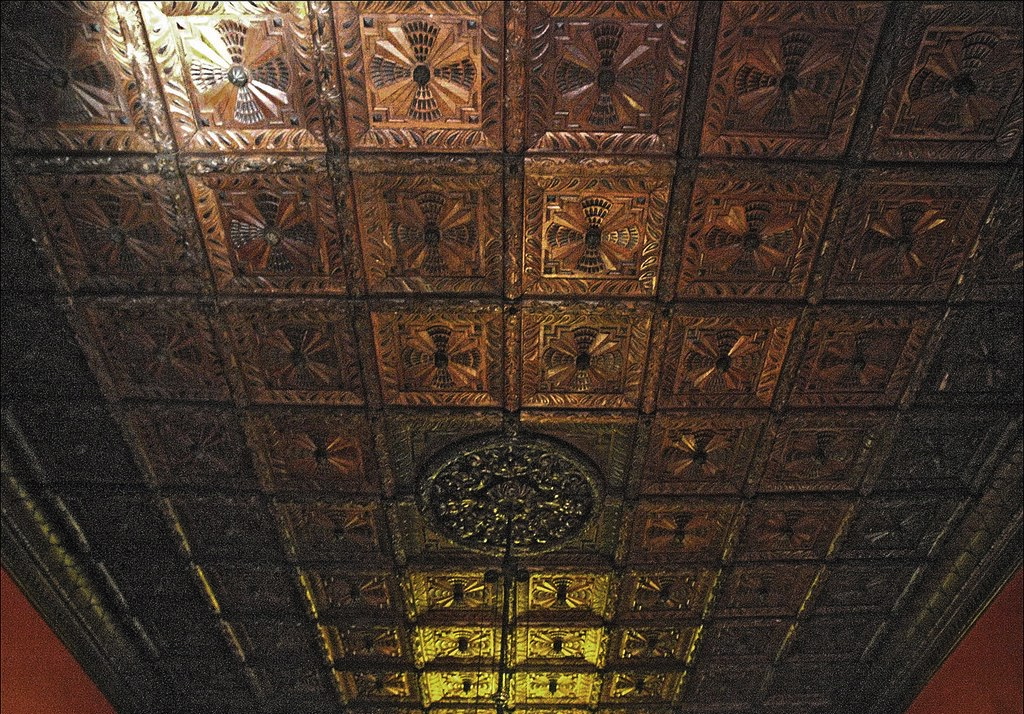
Martha was showing me a document in a glass case, a revolutionary-era Lima declaration of independence signed by one of the Aliagas, when I suddenly spotted an area cordoned off in a corner. I asked her what it was.
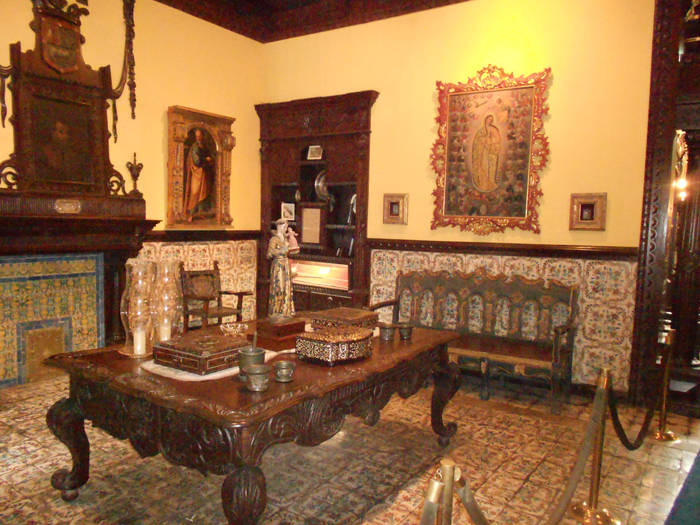
She smiled. “That? That’s the saber carried by Jerónimo Aliaga himself. It was lost for a time, then turned up in Chile, and was eventually restored to the family.”
So the story was true.
I strained to look more closely, but family rules were strict about entry into restricted areas. I had to content myself with a few grainy snapshots. Just knowing, however, that a conquistador’s sword was here, older than the house, older than Lima itself, was astonishing. It had gone from the bladesmith’s hands in Germany, to Spain, to Panama, where Aliaga fought in his first campaign, to Cajamarca and the execution of the great Inca, to Cuzco, to Chile. And now it was here.
Here, indelibly and unmistakably.
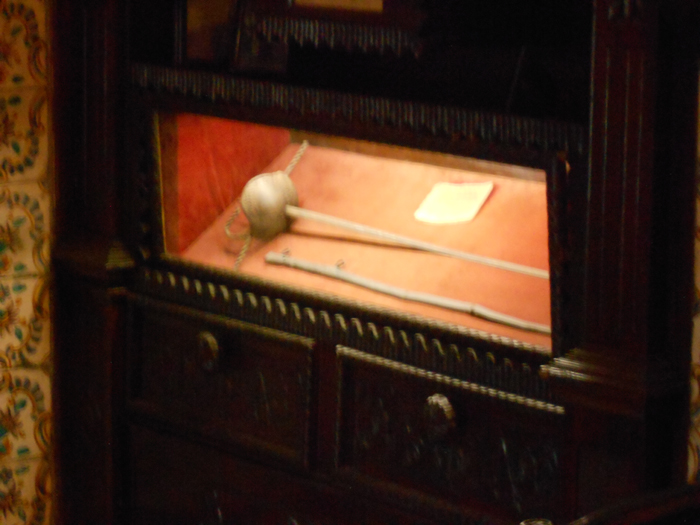
A final look around, then Martha and I descended the staircase. More than ever, Lima appeared to me unfathomable, a place where the deep past endures, unnoticed, right before one’s eyes.
Heat and noise from the street spilled into the ancient sanctuary as we stepped back into the present day.
Casa Aliaga
Jirón de la Unión 224 (Lima Centro)
427-7736
Martha Tolmos León (guide)
985-092-743
tolmosleon@hotmail.com